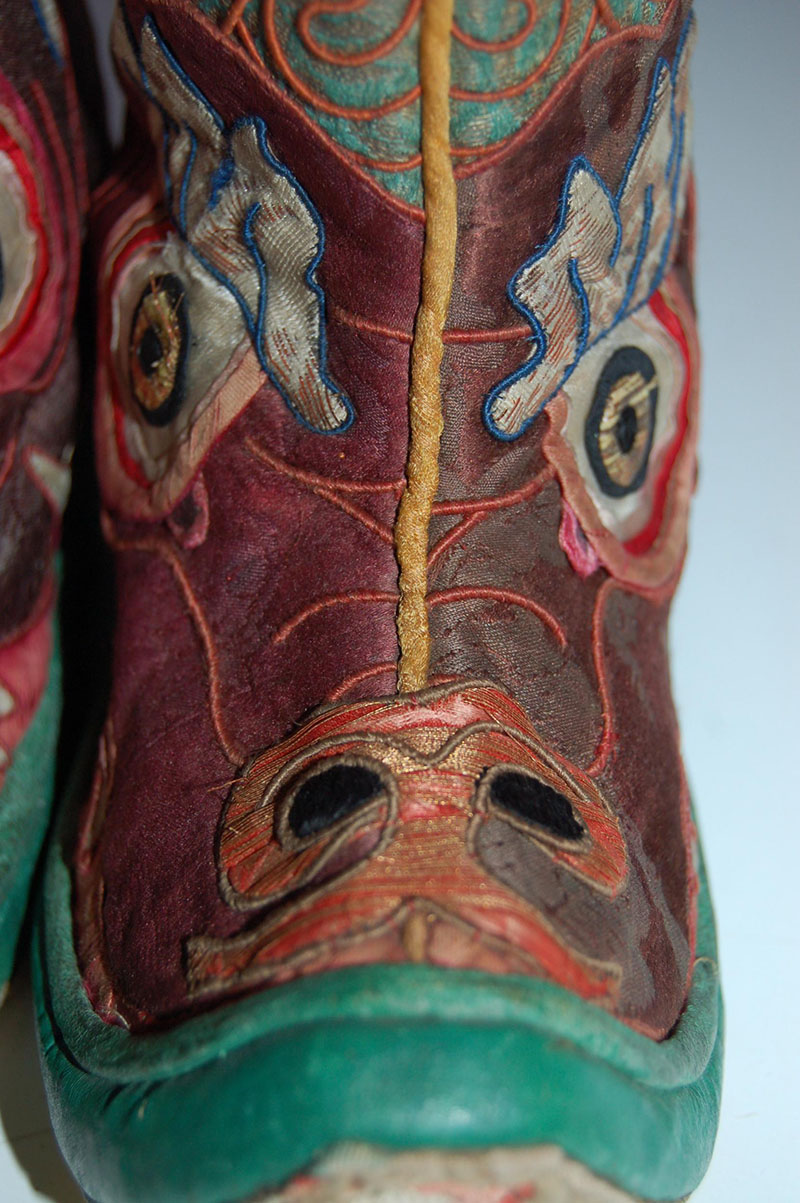Knee-high, warm and durable footwear made by the Tibetan community in Kalimpong, West Bengal since their migration to the region in the 1950s, are known as Tibetan stitched boots. These boots are made by sewing together layers of leather and brocade fabric and are meant to protect the wearer from the cold and uneven ground in mountainous areas.
Each boot is constructed in three main parts: the upper portion, extending from the knee to the ankle; the lower portion, or the shoe, which wraps around the foot; and the sole. Additionally, two smaller pieces for the toe and the heel are stitched onto the shoe. A rice water adhesive called laie is used when preparing the material of these boots and is used to glue sheets of jute cloth together while a plain white cotton cloth is applied as the outermost layer. This is then pressed and evened out with a plank of wood and dried in the sun. An outline of the upper and lower segments of the shoe’s design is traced on the sheet to be cut. Leather, made from oxhide or cowhide, is also cut as per this shape and stitched onto the pieces on the inside. An embroidered or brocaded fabric, usually made of corduroy or the traditional pulu, a felted woollen cloth, is stitched on the outside of the upper and – depending upon the design – lower segment. The two segments are stitched together using piping, which adds to the embroidered look of the boot while also strengthening its construction. Piping is also added around the edges of the toe and heel once those are attached to the shoe. The sole is cut from the jute fabric sheet, leather, a rubber sheet and thick card paper, all of which are stacked and glued together to ensure that the wearer’s foot is completely insulated from the cold terrain. Finally, the sole is stitched onto the rest of the boot. Wooden rods are vertically inserted into the boot at various angles to stretch it enough that it becomes comfortable to wear and remove.
Additionally, an opening at the back of the boot can be tightened or loosened as it is being put on, they are worn without socks and there is no distinction between the left and right boot. The toe of the boot can be hooked, pointed, squared or rounded, depending on the design of each pair. The embellishment applied to these boots varies according to region, gender and profession, although the modestly decorated Ghalo boots have historically been the most common and meant for functional, everyday use like walking and herding yak. The specific varieties, meant for high-status members of the community, are usually worn ceremonially while still being practical. The different types of stitched boots include Sombas, red boots worn by women; Lhams, or black boots worn by men; Ration, colourful intricately decorated boots worn by Buddhist monks; Pumalam, worn by dancers from the Utsang region of Tibet; and red Teylam, worn by the warrior sect from the Kham region.
Today, only three workshops in Kalimpong continue to produce the boots. Raising concerns about the future of the craft, artisans have noted that the younger generation is uninterested, considering Tibetan stitched boots unfashionable. The boots, which were originally meant to be worn daily and for long periods of time, are now usually part of ceremonial attire, replaced in daily wear by mass-produced, affordable footwear. Apart from locals in Kalimpong, the highest demand for these boots comes from the Tibet Autonomous Region, Tibetan settlements in Himachal Pradesh, Bhutan and Nepal, and to a lesser extent from tourists in Kalimpong.







